Lowrance electronic AirMap 1000 User Manual
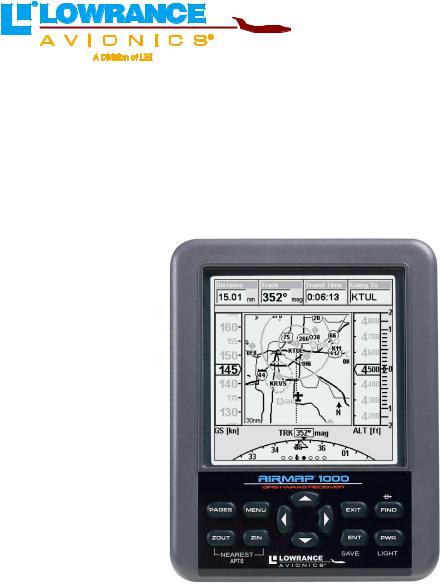
AirMap 1000
Aviation Mapping GPS Receiver
Operation Instructions

Copyright © 2003 Lowrance Electronics, Inc. All rights reserved.
AirMap , Lowrance Avionics and Lowrance are all registered trademarks of Lowrance Electronics, Inc.
Jeppesen is a registered trademark of Jeppesen Sanderson, Inc. Navionics is a registered trademark of Navionics, Inc. DURACELL is a registered trademark of Duracell, Inc. RAYOVAC is a registered trademark of Rayovac Corporation.
 Points of Interest Data in this unit are by infoUSA,
Points of Interest Data in this unit are by infoUSA,  copyright 2001-2003, All Rights Reserved. infoUSA is a trademark of infoUSA, Inc.
copyright 2001-2003, All Rights Reserved. infoUSA is a trademark of infoUSA, Inc.
eXitSource Database, copyright 2001-2003 Zenrin Co. Ltd. Exit Authority and eXitSource are trademarks of Zenrin Co. Ltd.
Lowrance Electronics may find it necessary to change or end our policies, regulations and special offers at any time. We reserve the right to do so without notice. All features and specifications subject to change without notice. All screens in this manual are simulated.
For free owner's manuals and other information, visit our web site:
www.lowrance.com
Lowrance Electronics Inc.
12000 E. Skelly Dr.
Tulsa, OK USA 74128-2486
Printed in USA.
Table of Contents |
|
Sec. 1: Read Me First! ............................................................... |
I |
Capabilities and Specifications .................................................... |
3 |
How Airmap Works ...................................................................... |
5 |
Introduction to GPS and WAAS................................................... |
7 |
How to Use this Manual: Typographical Conventions................ |
9 |
Sec. 2: Installation & Accessories ........................................ |
11 |
Power........................................................................................... |
11 |
MMC or Sd Memory Card Installation...................................... |
13 |
External Active Antenna............................................................ |
14 |
R-A-M Bracket Mounting System ............................................ |
15 |
Protective Bag............................................................................. |
16 |
Sec. 3: Aviation Operation..................................................... |
19 |
Keypad......................................................................................... |
19 |
Power/Lights (Turn Unit On and Off) ....................................... |
20 |
Main Menu .................................................................................. |
20 |
Pages ........................................................................................... |
22 |
Satellite Status Page .............................................................. |
23 |
Navigation Page...................................................................... |
25 |
Compass Rose with HSI and OBS Hold............................. |
26 |
Navigating with OBS Hold................................................. |
28 |
Map Page................................................................................. |
30 |
Full Map Page Display Option ........................................... |
31 |
Map Panel Page Display Option ........................................ |
34 |
Compass Overlay Page Display Option ............................. |
34 |
Digital Data Page Display Option...................................... |
35 |
Two Maps Page Display Option ......................................... |
37 |
Aviation GPS Quick Reference ............................................ |
39 |
Find your Current Position .................................................... |
40 |
Moving around the Map: Zoom & Cursor Arrow Keys.......... |
40 |
Selecting any Map Item with the Cursor............................... |
41 |
Searching................................................................................. |
41 |
Find Nearest Airport (Shortcut)............................................. |
43 |
Navigating to Nearest Airport with the Airmap ................... |
44 |
Setting a Waypoint ................................................................. |
44 |
Navigate Back to a Waypoint................................................. |
45 |
Navigate to Cursor Position on Map...................................... |
45 |
Navigate to a Point of Interest ............................................... |
46 |
Go "Direct to" (Using the Direct to Button)........................... |
46 |
Airspace Status ....................................................................... |
47 |
Airport Information ................................................................ |
47 |
Runways .............................................................................. |
48 |
Runway Approach Guidance Feature ................................ |
49 |
i |
|
Services................................................................................ |
50 |
Transfer Custom Maps and GPS Data Files ......................... |
50 |
Switch to Land Mode .............................................................. |
52 |
Switch Back to Aviation Mode from Land Mode ............... |
52 |
Aviation Calculators ................................................................... |
53 |
E6B Altitude/Airspeed Calculator.......................................... |
53 |
E6B Wind Speed/Direction Calculator................................... |
53 |
Vertical Navigation Calculator .............................................. |
54 |
Sec. 4: Land Operation ........................................................... |
57 |
Keypad......................................................................................... |
57 |
Power/Lights (Turn Unit On and Off) ....................................... |
58 |
Main Menu .................................................................................. |
58 |
Pages ........................................................................................... |
58 |
Satellite Status Page .............................................................. |
59 |
Navigation Page...................................................................... |
59 |
Map Page................................................................................. |
60 |
Moving around the Map: Zoom & Cursor Arrow Keys.............. |
61 |
Find Distance from Current Position to Another Location ...... |
61 |
Find Distance from Point to Point ......................................... |
62 |
Find your Current Position ........................................................ |
62 |
Icons............................................................................................. |
63 |
Create Icon on Map................................................................. |
63 |
Create Icon at Current Position ............................................. |
63 |
Delete an Icon ......................................................................... |
64 |
Load GPS Data Files from an MMC .......................................... |
64 |
Navigate ...................................................................................... |
65 |
Navigate Back to Man Overboard Waypoint......................... |
65 |
Cancel Navigation................................................................... |
65 |
Navigate a Route..................................................................... |
65 |
Navigate to Cursor Position on Map...................................... |
65 |
Navigate to an Icon................................................................. |
66 |
Navigate to Point of Interest (POI)........................................ |
66 |
Navigate to a Waypoint .......................................................... |
66 |
Navigate a Trail ...................................................................... |
66 |
Routes.......................................................................................... |
68 |
Create and Save a Route ........................................................ |
68 |
Delete a Route......................................................................... |
71 |
Save GPS Data Files to an MMC............................................... |
71 |
Searching..................................................................................... |
72 |
Switch to Aviation Mode............................................................. |
73 |
Switch Back to Land Mode from Aviation Mode ................... |
74 |
Trails ........................................................................................... |
74 |
Create and Save a Trail.......................................................... |
74 |
ii |
|
Delete a Trail .......................................................................... |
75 |
Edit a Trail Name ................................................................... |
75 |
Transferring GPS Data Files ..................................................... |
75 |
Utilities........................................................................................ |
75 |
Alarm Clock............................................................................. |
75 |
Sun/Moon Rise & Set Calculator............................................ |
75 |
Trip Calculator........................................................................ |
76 |
Trip Down Timer..................................................................... |
76 |
Trip Up Timer ......................................................................... |
76 |
Waypoints.................................................................................... |
76 |
Create a Waypoint .................................................................. |
76 |
Create a Man Overboard Waypoint ....................................... |
76 |
Selecting a Waypoint .............................................................. |
77 |
Delete a Waypoint................................................................... |
78 |
Edit a Waypoint (Name, Symbol, Position and Altitude) ..... |
78 |
Sec. 5: System & GPS Setup Options................................... |
79 |
Alarms ......................................................................................... |
79 |
Aviation Alarms .......................................................................... |
80 |
Auto Satellite Search.................................................................. |
81 |
Battery Indicator ........................................................................ |
82 |
Check MMC Files and Storage Space........................................ |
82 |
Com Port Configuration ............................................................. |
82 |
Coordinate System Selection...................................................... |
83 |
Map Fix.................................................................................... |
84 |
Customize Page Displays ........................................................... |
86 |
GPS Simulator ............................................................................ |
86 |
Map Auto Zoom........................................................................... |
87 |
Map Data..................................................................................... |
87 |
Show Map Data....................................................................... |
88 |
Pop-Up Map Info..................................................................... |
88 |
Map Boundaries ...................................................................... |
88 |
Fill Land Gray......................................................................... |
88 |
Map Overlays (Range Rings; Lat/Long Grid) ........................ |
88 |
Map Datum Selection ................................................................. |
89 |
Map Detail Category Selection................................................... |
90 |
Map Orientation ......................................................................... |
90 |
Navionics Charts....................................................................... |
91 |
Pop-Up Help................................................................................ |
96 |
Reset Options .............................................................................. |
97 |
Require DGPS ............................................................................. |
98 |
Screen Contrast and Brightness ................................................ |
98 |
Set Local Time .......................................................................... |
100 |
Software Version Information.................................................. |
101 |
iii |
|
Sounds and Alarm Sound Styles.............................................. |
101 |
Track Smoothing....................................................................... |
102 |
Trail Options ............................................................................. |
103 |
Flash Trails on Screen Option.............................................. |
103 |
Update Active Trail Option .................................................. |
103 |
Update Trail Criteria (Auto, Time, Distance) ..................... |
104 |
Trail Update Rate (Time, Distance)..................................... |
105 |
New Trail............................................................................... |
105 |
Units of Measure....................................................................... |
106 |
Set Language ............................................................................ |
107 |
Sec. 6: Searching.................................................................... |
109 |
Aviation Mode Searches ........................................................... |
109 |
Find an Airspace (Using Cursor) ......................................... |
109 |
Find Airports (Aviation Mode only) ..................................... |
110 |
Find VORs (Aviation Mode only).......................................... |
111 |
Find NDBs (Aviation Mode only) ......................................... |
113 |
Find Intersections (Aviation Mode only).............................. |
115 |
Land Mode Searches................................................................. |
116 |
Find Addresses...................................................................... |
116 |
Find any Item Selected by Map Cursor ............................... |
118 |
Find Interstate Highway Exits ............................................ |
118 |
Find Map Places.................................................................... |
120 |
Find Streets or (Street) Intersections .................................. |
122 |
Find Waypoints ..................................................................... |
123 |
Sec. 7: Supplemental Material............................................ |
125 |
Index......................................................................................... |
131 |
WARNING!
A CAREFUL NAVIGATOR NEVER RELIES ON ONLY ONE METHOD TO OBTAIN POSITION INFORMATION.
CAUTION
When showing navigation data to a position (waypoint), a GPS unit will show the shortest, most direct path to the waypoint. It provides navigation data to the waypoint regardless of obstructions. Therefore, the prudent navigator will not only take advantage of all available navigation tools when traveling to a waypoint, but will also visually check to make sure a clear, safe path to the waypoint is always available.
WARNING!
When a GPS unit is used in a vehicle, the vehicle operator is solely responsible for operating the vehicle in a safe manner. Vehicle operators must maintain full surveillance of all pertinent driving, boating or flying conditions at all times. An accident or collision resulting in damage to property, personal injury or death could occur if the operator of a GPS-equipped vehicle fails to pay full attention to travel conditions and vehicle operation while the vehicle is in motion.
iv
Section 1: Read Me First!
How this manual can get you flying, fast!
Welcome to the exciting world of GPS! We know you're anxious to take off and begin navigating, but we have a favor to ask. Before you grab the batteries and head for the plane, please give us a moment or two to show you how to skip around our manual for the information you need. (Tips start on page 2.) We want to help you get the best performance from this versatile little GPS unit — in the air, on the ground and on the sea!
Before we go any further, we want to thank you for buying an AirMap 1000. Whether you're a first time GPS user or a professional navigator, you'll find that the AirMap 1000 includes a complete set of powerful aeronautical mapping and navigation features, yet is easy to use. How easy? Well, if you've already figured out how to load the card and batteries yourself, and you just can't wait any longer, turn to the Quick Reference on page 39 and head outside with your AirMap! You can be practicing touch-and-goes at a nearby airport in only 12 steps.
Not in that big of a hurry? Good, because we really recommend you practice a bit before taking your AirMap aloft. The AirMap 1000 is a powerful GPS+WAAS receiver, but its slim silhouette is crammed with lots of extra features and value. You don't need to learn them all right away, but a little practice on the ground will help you become familiar with AirMap's capabilities — and make you a safer pilot. Flying, of course, is why you bought an AirMap, but it's like having three different GPS receivers in one. Here are the other two reasons why.
Need business or pleasure travel directions or phone numbers after landing? You don't need another GPS — when you leave the cockpit, just slip your AirMap into your briefcase or luggage and take advantage of the fully-functional Land Navigation Mode. With your own cus- tom-built MapCreate 6 map, your AirMap can use a massive searchable Point of Interest database of businesses and attractions to lead you to your final destination. (Land Mode Operation is described in Section 4; Searching is covered in Section 6.)
And AirMap performance doesn't stop at the water's edge. If your destination is a boating or fishing adventure, your AirMap will help you safely navigate the Great Lakes and coastal U.S. waters with our 70,000-item database of marine navigation aids, wrecks and obstructions. (This also requires a MapCreate map; functions are discussed in Section 4. The MapCreate manual has an Easy Mode Quick Reference of its own; it'll help you make a map in just 6 steps.)
1
Whether your AirMap 1000 is the only GPS in the cockpit or backing up an in-panel display, you're using the most versatile and most affordable large-screen hand-held GPS receiver in the aviation market today.
Our goal for this book is to get you in the air (or out on the road) fast, with a minimum of fuss. Like you, we'd rather spend more time flying, and less time reading the manual!
So, we designed our book so that you don't have to read the whole thing from front to back for the information you want. At the start (or end) of each segment, we'll tell you what content is coming up next. If it's a concept you're already familiar with, we'll show you how and where to skip ahead for the next important topic.
You may be the button-pushing type who just likes to play with the GPS first, before peeking inside the manual. That’s fine, because AirMap menus have a pop-up Help feature that will answer many of your questions. If this is your learning style, turn to the installation instructions in Section 2, then step outdoors with your unit. When you come to a menu command you want to learn more about, jut turn to the Table of Contents or the Index and look it up.
The manual is organized into six sections. If you’re new to GPS, prefer a tutorial approach to learning or just want to explore more of the awesome features in your AirMap, we suggest you skim some of these sections more closely.
This first section is an introduction to AirMap, GPS and WAAS. It tells you the basics you need to know before you can make AirMap look around and tell you where you are.
Section 2, Installation, will help you get the batteries and MultiMedia Card (MMC) correctly installed in your AirMap. (The card contains the Jeppesen Americas and Lowrance Obstructions aeronautical databases.) We'll also tell you how to install the RAM mounting bracket on a yoke and the RAA-3 remote active antenna in an aircraft window or on top of the instrument panel.
Section 3 is really the heart of our book, Aviation Mode Operation. It will introduce you to the basic airborne GPS functions. This section includes the one-page Aviation Mode Quick Reference we mentioned earlier. The rest of Section 3 contains short, easy-to-scan lessons that follow one another in chronological order. They're all you'll need to know to get in the air quickly.
Aviation Mode instructions are only 30 pages long, and these lessons will meet the navigation needs of many pilots. But, after you've learned the basics (or if you already have some GPS experience), you may want
2
to try out some of AirMap's many advanced features. That brings us to Section Four, Land Mode Operation. After we introduce the Land Mode menus and submenus, the rest of the section contains AirMap's more advanced command functions.
Your AirMap is ready to use right out of the box, but you can fine tune and customize its operation with dozens of options. We describe how to use them in Section 5, System Setup and GPS Setup Options. This section covers both Aviation Mode and Land Mode options.
Finally, in Section 6, we go into more detail on one of AirMap's most remarkable capabilities — Searching. We'll introduce a couple of search examples in both the Aviation and Land mode sections, but there are so many map and aeronautical items you can search for, we had to give this function its own section in the manual! For example, we mentioned telephone numbers earlier. Your AirMap can function as a virtual Yellow Pages, and we’ll show you how in Section 6.
Now, if you're into the fine details, glance over the next segment on specifications to see just how much GPS power this little unit holds. It's important to us (and our power users), but, if you don't care how many waypoints AirMap can store or how long the batteries last, skip ahead to important information on how AirMap works, on page 5.
Capabilities and Specifications
Display:............................ |
5" (12.7 cm) diagonal high contrast Film Su- |
|
perTwist LCD with 16-level grayscale. |
Resolution:...................... |
320 pixel x 320 pixel resolution; 102,400 total |
|
pixels. |
Backlighting:.................. |
White LED screen and keypad backlighting |
|
for night and low-light viewing. |
Input power:...................... |
6 volts DC (four 1.5v AA batteries); operates up |
|
to 12 hours on batteries when using one-second |
|
position updates (longer update rates and op- |
|
tional power saving settings further extend |
|
battery life, but will reduce GPS accuracy). |
|
Cigarette lighter power adapter included. |
Case size:......................... |
6.25" H x 4.9" W x 2.5" D (16 x 12.5 x 6.4 cm); |
|
water resistant to IPX-2 standards. |
Weight:............................. |
1.2 ounces (552 grams) with batteries. |
Receiver: ......................... |
Internal, 12 parallel channel GPS+WAAS; |
|
RAA-3 advanced active remote external an- |
|
tenna included. |
|
3 |
Recording: ...................... |
Removable MMC or SD memory cards for |
|
recording GPS trip details, displaying cus- |
|
tom maps, upgrading operating system soft- |
|
ware and transferring trip data to personal |
|
computer without a slow serial connection. |
|
USB card reader included with unit. |
MMC slots: ...................... |
One, inside battery compartment. Accepts |
|
non-proprietary MMC or SD memory cards. |
Aeronautical map: ........ |
Jeppesen Americas database with airports, |
|
VORs, NDBs, intersections and airspaces |
|
(including Class D). Lowrance Obstructions |
|
database displays ground obstructions in |
|
AGL or MSL heights. |
Background map:.......... |
Built-in custom, detailed Lowrance map. |
|
Contains: low-detail maps of the whole world |
|
(containing cities, major lakes, major rivers, |
|
political boundaries); and medium-detail |
|
maps of the United States (containing all in- |
|
corporated cities; Interstate, U.S. and state |
|
highways; Interstate highway exits and exit |
|
services information; largeand medium- |
|
sized lakes and streams.) |
Custom mapping: .......... |
Accepts custom, higher-detail MapCreate 6 |
|
mapping on memory cards, with searchable |
|
Points-of Interest database of hotels, restau- |
|
rants, shopping, services and more. Navion- |
|
ics charts on MMC cards optional. |
Mapping memory: ......... |
Up to 512 MB on one MMC (MultiMedia |
|
Card) or SD (Secure Digital Card.) |
Position updates: .......... |
Every one second. |
Position points: ............. |
1,000 waypoints; 1,000 event marker icons. |
Graphic symbols for |
|
waypoints or event |
|
marker icons: ................. |
42. |
Routes:............................. |
100; up to 100 waypoints per route. |
Plot Trails:...................... |
100 savable; up to 10,000 points per trail. |
Nearest Airport: ............ |
Quickly locates an airfield closest to your |
|
current position. (Aviation Mode only.) |
4
Man Overboard:............. MOB feature precisely marks man overboard location with special icon, then automatically displays navigation data to that position.
(Land Mode only.)
Com Port:........................ One serial communications port, NMEA 0183 version 2.0 compatible. Allows exchange of position data with another device, such as an autopilot or personal computer. Optional combination serial/power cable available.
Zoom range:.................... 39 ranges; 0.02 to 4,000 miles.
NOTE:
The above memory capacities refer only to AirMap's on-board memory. The amount of GPS data you can record and save for recall later is only limited by the number of MMC cards you carry with you.
How AirMap Works
You'll navigate faster and easier if you understand how AirMap scans the sky to tell you where you are on the earth — and, where you're going. (But if you already have a working understanding of GPS receivers and the GPS navigation system, skip on ahead to Section 2, Installation & Accessories on page 11. If you're new to GPS, read on, and you can later impress your friends with your new-found knowledge.)
First, think of your AirMap as a small but powerful computer. (But don't worry — we made AirMap so easy to use, you don't need to be a computer expert to find your way!) The unit includes a keypad and a screen with menus so you can tell AirMap what to do. The screen also lets AirMap show your location on a moving map, as well as point the way to your destination.
This "computer" also contains an antenna and specialized scanning receiver, something like your car radio. But instead of your favorite dance tunes or VOR signals, this receiver tunes in to a couple of dozen GPS satellites circling the earth. (WAAS satellites, too, but more about them later.)
AirMap listens to signals from as many satellites as it can "see" above the horizon, eliminates the weakest signals, then computes its location in relation to those satellites. Once the AirMap figures its latitude and longitude, it plots that position on the map shown on the screen. While the screen is updated once a second the internal calculations are done several times a second.
The performance doesn't stop there. Stored in the permanent memory of each AirMap is a basic background map of the entire world. (For just
5
what's in the map, see the preceding segment on specifications.) We lock it in here at the factory — you can't change or erase this map.
The background map, along with the Jeppesen and Lowrance aeronautical databases, are all you need for aerial navigation. (Your unit reads these databases automatically from the MMC card included in the package.)
The background map is also suitable for many land and marine navigation chores, but for maximum surface accuracy and much more detail, you need a custom map from MapCreate 6. Some AirMap features — such as searching for businesses and addresses — won't work without a custom MapCreate map. There is so much detail in our background map (and even more in MapCreate) that we'll compare their contents and differences in Section 3, Aviation Mode Operation.
Another portion of AirMap's onboard memory is devoted to recording GPS navigation information, which includes waypoints, event marker icons, trails and routes. This lets you plan a route for a flight or look back the way you came. Think of this data storage like the hard drive memory in a computer. You can save several different GPS data files, erase 'em and record new ones, over and over and over again. Like any computer file, these GPS Data Files (file format *.usr) can be shared between AirMaps, other Lowrance GPS or sonar/GPS units, even personal computers.
AirMap has one more thing in common with a personal computer. Just as computers have a floppy disk drive for storing and exchanging files, AirMap has a slot for an MMC (MultiMedia Card) or SD card (Secure Digital Card) flash memory card. These solid-state memory devices are about the size of a postage stamp, but can hold data ranging from 8 MB to 512 MB in size. (Compare that to a floppy disk's 1.44 MB capacity!) AirMap uses all that MMC space for two key purposes.
First, you can backup your onboard GPS Data Files by copying them to the MMC. Since the MMC is removable (like a floppy disk or a video tape), you can store these GPS Data Files on a personal computer equipped with an MMC card reader. (Or store them on a pocketful of MMCs, if you don't have a computer handy.) Our MapCreate mapping software can save, edit or create its own GPS Data Files, which can be copied to the MMC and then loaded from the MMC into AirMap's memory. (NOTE: No matter where they come from, GPS Data Files must be loaded from the MMC into memory before AirMap can use them.)
As we mentioned earlier, the other key use for MMCs is storage of the aeronautical databases and high-detail maps from MapCreate. These Custom Map Files (file format *.lcm) can also be shared between AirMaps, other Lowrance GPS or sonar/GPS units and personal computers.
6
You make your own Custom Map Files with our MapCreate software, but you don't have to. We also sell ready-to-use FreedomMaps . These custom maps are pre-loaded on MMCs. (No computer work required!).
Introduction to GPS and WAAS
Well, now you know the basics of how AirMap does its work. You might be ready to jump ahead to Section 2, Installation & Accessories, on page 11, so you can install the batteries. Or you might want to see how our text formatting makes the manual tutorials easy to skim. If that's the case, move on to "How to Use This Manual" on page 9. But, if you want to understand the current state of satellite navigation, look over this segment describing how GPS and its new companion WAAS work together to get you where you're going.
First of all, why are pilots so excited about GPS navigation? GPS is more accurate than other navaids, such as VOR and NDB. GPS is free of environmental limitations that affect other navigation systems and it's available worldwide. GPS receivers like your AirMap are highly affordable, easy to use and not confined to your cockpit! GPS frees a pilot to accurately navigate to or from virtually any map place on earth — navigation is no longer limited to the aeronautical navaid network. With a mapping GPS, a pilot always knows exactly where he is. A GPS receiver makes it easier for a pilot to apply wind correction angles and fly true headings, as well as determine true ground speed.
The Global Positioning System (GPS) was launched July 17, 1995 by the United States Department of Defense. It was designed as a 24- hour-a-day, 365-days-a-year, all weather global navigation system for the armed forces of the U.S. and its allies. Civilian use was also available at first, but it was less accurate because the military scrambled the signal somewhat, using a process called Selective Availability (SA).
GPS proved so useful for civilian navigation that the federal government discontinued SA on May 2, 2000, after the military developed other methods to deny GPS service to enemy forces. Reliable accuracy for civilian users jumped from 100 meters (330 feet) under SA to the present level of 10 to 20 meters (about 30 to 60 feet).
Twenty-four satellites orbit 10,900 nautical miles above the Earth, passing overhead twice daily. A series of ground stations (with precisely surveyed locations) controls the satellites and monitors their exact locations in the sky. Each satellite broadcasts a low-power signal that identifies the satellite and its position above the earth. Three of these satellites are spares, unused until needed. The rest virtually guarantee that at least four satellites are in view nearly anywhere on Earth at all times.
7
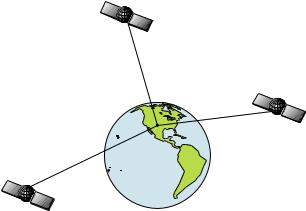
A minimum of three satellites are required to determine a 2D fix.
The system requires signal reception from three satellites in order to determine a position. This is called a 2D fix. It takes four satellites to determine both position and elevation (your height above sea level — also called altitude). This is called a 3D fix.
Remember, the unit must have a clear view of the satellites in order to receive their signals. Unlike radio or television signals, GPS works at very high frequencies. These signals can be easily blocked by trees, buildings, an automobile roof, a wing, even your body.
Like most GPS receivers, AirMap doesn’t have a compass or any other navigation aid built inside. It relies solely on the signals from the satellites to calculate a position. Speed, direction of travel, and distance are all calculated from position information. Therefore, in order for AirMap to determine direction of travel, you must be moving and the faster, the better. This is not to say that it won’t work at walking or boat trolling speeds — it will. There will simply be more "wandering" of the data shown on the display.
GPS is plenty accurate for route navigation, but the U.S. Federal Aviation Administration has special needs for aircraft traffic control that go beyond basic GPS. The FAA has a plan under way to boost GPS performance even further with its Wide Area Augmentation System, or WAAS. This GPS add-on will include a time control element that will help airliners fly closer together while avoiding collisions. In addition to carefully spacing airplanes along travel corridors, WAAS will eventually make instrument landings and takeoffs more accurate as it replaces existing aviation navigation systems.
8
WAAS signals make your GPS navigation even more accurate. Your AirMap automatically receives both GPS and WAAS signals. However, WAAS has some limits you should know about.
First, the U.S. government has not completed construction of the WAAS system, so it is not yet fully operational. The ground stations are in place, but only a few of the needed WAAS satellites have been launched.
WAAS can boost the accuracy of land and marine GPS navigation, but the system is designed for aircraft. The satellites are in a fixed orbit above the Equator, so they appear very low in the sky to someone on the ground in North America. Aircraft and vessels on open water can get consistently good WAAS reception, but terrain, foliage or even large man-made structures frequently block the WAAS signal from ground receivers.
You'll find that using your GPS+WAAS receiver is both easy and amazingly accurate. It’s easily the most accurate method of electronic navigation available to the general public today. Remember, however, that this receiver is only a tool. As this manual goes to press, the FAA has not yet certified any hand-held GPS+WAAS receivers for use as the sole navigation aid for VFR pilots. Always have another method of navigation available, such as a sectional chart and your aircraft's magnetic and gyro compasses, or a conventional nav/com radio.
Also remember that this unit will always show navigation information in the shortest line from your present position to an airport, VOR or other waypoint, regardless of obstacles and terrain! It only calculates position, it can’t know what’s between you and your destination, for example. It’s up to you to safely navigate around obstacles and rising terrain, no matter how you’re using this product.
How to use this manual: typographical conventions
Many instructions are listed as numbered steps. The keypad and arrow "keystrokes" appear as boldface type. So, if you're in a real hurry (or just need a reminder), you can skim the instructions and pick out what menu command to use by finding the boldface command text. The paragraphs below explain how to interpret the text formatting for those commands and other instructions:
Arrow Keys
The arrow keys control the movement of dotted cross-hair lines on your mapping screen called the cursor. The arrow keys also help you move around the AirMap menus so you can execute different commands. They are represented by symbols like these, which denote the down arrow key, the up arrow, the left arrow and the right arrow: ↓ ↑ ← →.
9
Keyboard
The other keys perform a variety of functions. When the text refers to a key to press, the key is shown in bold, sans serif type. For example, the "Enter/Save" key is shown as ENT and the "Menu" key is shown as MENU.
Menu Commands
A menu command or a menu option will appear in small capital letters, in a bold sans serif type like this: SYSTEM SETUP. These indicate that you are to select this command or option from a menu or take an action of some kind with the menu item. Text that you may need to enter or file names you need to select are shown in italic type, such as trail name.
Instructions = Menu Sequences
Most functions you perform with AirMap are described as a sequence of keystrokes and selecting menu commands. We've written them in a condensed manner for quick and easy reading.
For example, instructions for deleting all icons from memory would look like this:
1.Press MENU|↓ to DELETE MY ICONS|ENT|ENT.
2.Press ← to YES|ENT.
3.Press EXIT.
Translated into complete English, step 1 means: "Press the Menu key. Next, press the down arrow key to scroll down the menu and select (highlight) the Delete My Icons menu command. Finally, press the Enter key twice."
Step 2 means: "Press the left arrow key to select Yes, then press Enter."
Step 3 means: "Press the Exit key to clear the menu and return to the Map Page."
Important Keyboard Shortcut Tip:
There are often three ways to move around an AirMap menu. For simplicity, we've written our instructions using the Enter key (ENT) to complete a move from one menu to the next. However, many commands have shortcuts that will help your fingers fly across the keys. Almost every page menu command lets you press ← or → instead of ENT. This is always true for commands with an ellipses (MAP DATA…) or an arrow (GPS SETUP ►). Our menus also "wrap around;" that is, they form a circular loop. This means when you open a menu and need to reach the bottom command, you can get there by pressing ↑ one time instead of holding or repeatedly pressing ↓. A cockpit can be a busy place; practice with these shortcuts and you can run AirMap commands faster, with less finger movement from key to key.
10
Section 2:
Installation & Accessories
Power
The AirMap operates from AA batteries or on 6 volts DC using an optional external power cable with a cigarette lighter adapter. If the power cable is used, the AirMap automatically switches to it if the external power is greater than the battery voltage. If the external power fails, the unit automatically switches to the batteries.
NOTE:
Some pilots like to keep fresh batteries in their units, even when using the external power. If the power fails, the unit will automatically switch to the batteries, thus keeping the unit on without interruption.
Flash memory and an internal lithium battery will keep your stored data safe and accessible for the life of the product.
Batteries
The unit requires four 1.5-volt AA batteries. We recommend that you use alkaline batteries for the best trade-off between battery life and cost. We recommend DURACELL brand, but other brands will work. If you're looking for an extended-life battery, the Duracell ULTRA battery has performed well in our tests.
You can also use rechargeable AA alkaline batteries, such as those made by RAYOVAC , or rechargeable AA nickel metal hydride (NiMH) batteries. We do not recommend nickel cadmium (NiCd) rechargeable batteries because you will get poor battery life.
Rechargeable alkaline batteries will not last as long as standard alkaline batteries. NiMH batteries are rechargeable and should also give you suitable battery life.
Do not mix different battery types. Mixing battery types may cause leakage. (For example, don’t use both alkaline and NiMH batteries at the same time, and don't use standard alkalines with rechargeable alkalines.)
Battery Installation
Turn the unit over so that the back is facing you and loosen the thumbscrew at the bottom of the battery case. Place your fingers in the ridged
11
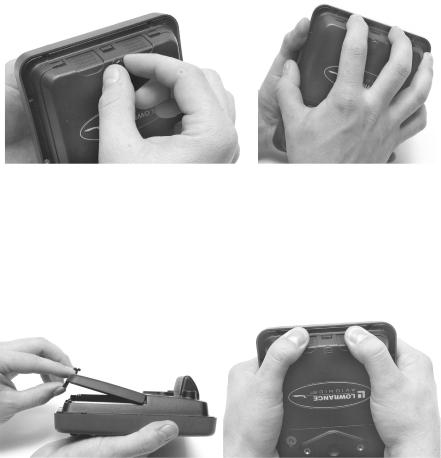
grips on the outside edge of the battery compartment cover. Press in on the grips and lift the cover away from the unit case. The battery cover will pull free.
Loosen thumbscrew and remove AirMap battery cover.
Install the batteries according to the decal in the battery compartment, which shows the correct polarity. Point the positive pole of the leftmost battery down, and alternate them as you move right.
Replace the battery compartment cover. Align the cover latch tabs with the slots inside the case. Slide the cover into place, and then push down on the bottom edge until the cover snaps into place.
Replace battery compartment cover:
Slide cover into place, left. Press in cover's bottom edge, right
Cigarette Lighter Power Adapter
To use external DC power: Plug the power cable's cigarette lighter adapter into a cigarette lighter receptacle. Next, firmly press the cable's connector into the socket on the back of the AirMap's case.
12

Attach external power cable to AirMap.
MMC or SD Memory Card Installation
Your AirMap uses a MultiMedia Card to store information, such as custom maps, waypoints and other GPS data. The unit can also use Secure Digital Cards (SD cards) to store information.
NOTE:
Throughout this manual, we will use the term MMC, but just remember that your unit can use an MMC or SD card to store data.
Both of these solid-state flash memory devices are about the size of a postage stamp. An SD card is slightly thicker than an MMC. As this manual went to press, MMCs were available in storage capacities of 8 MB, 16 MB, 32 MB and 64 MB. SD cards were available in capacities of 8 MB, 16 MB, 32 MB, 64 MB, 128 MB, 256 MB and up. We have tested SD cards up to 256 MB.
Additional MMC cards are available from LEI Extras; see ordering information inside the back cover of this manual. MMCs and SD cards are also available at many consumer electronics stores.
The MMC slot is located in the battery compartment, next to the batteries on the right side of the unit.
To remove an MMC
1. Remove battery compartment cover.
Drag the MMC from its slot by pressing against its label.
13
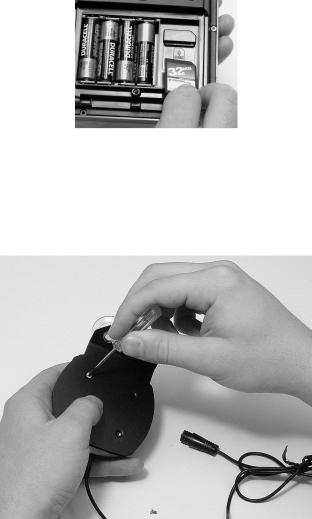
2. Hold unit facedown in left hand. With your right hand, press a finger against the label of the MMC and drag it from the slot.
To add an MMC or SD Card
1.Remove battery compartment cover.
2.Hold the unit in one hand. Grasp the bottom edge of the MMC with your other hand. The MMC label should be toward you.
3.Fit the top edge (notched) edge of the MMC into MMC slot.
4.With your finger on the card's label, gently push the card into the slot.
Fit the MMC into its slot and then press it into position.
5. Replace the battery cover. (Remember to tighten the thumb screw.)
External Active Antenna
A GPS antenna requires a clear view of the sky for optimum operation. Inside the cockpit, your AirMap can sometimes maintain satellite lock while sitting on the yoke or seat beside you, but we don't recommend this for optimum performance.
Attach AirMap antenna to windshield bracket with two screws.
14
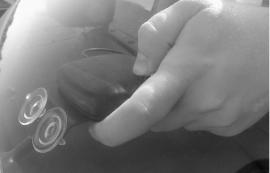
Since the "view" is restricted to what can be seen through the window, this operating mode will reduce position accuracy and will increase the chance of losing satellite lock. Inside a plane, the unit operates best with an external antenna mounted on the windshield or dash.
You may achieve good results by simply placing the external RAA-4 antenna on the top of the dash, at the base of the windshield. Many pilots like to attach the antenna to the top of their instrument panel glare shields. Depending on the surface, a strip of adhesive Velcro or a piece of the rubber non-skid shelf liner material available in recreational vehicle supply stores will help hold the antenna in place.
We recommend attaching the antenna to your windshield or other window. For this reason, the remote active antenna packaged with your AirMap includes a suction-cup mount. Be sure to mount the antenna in a location where it will not obstruct your view.
Press suction cup plate firmly against a window with unobstructed view.
Wherever you mount the antenna, make sure it is in a location with an unobstructed view of the sky. If you're sticking it to a window, moisten the suction cups on the mounting plate and press firmly against the window. Route the cable so that it won't interfere with flying. Then, simply plug the connector into the unit's antenna socket, located on the back, in the upper left corner of the case. The AirMap will automatically switch to use the RAA-4 remote antenna when plugged in.
R-A-M Bracket Mounting System
A R-A-M mounting bracket is shipped with your AirMap. The mounting arm and cradle can swivel on a ball for easy viewing in any type of vehicle.
Attach the mounting bracket to the stem of the yoke. Then, tighten the knob at the bracket's base to keep the bracket from sliding around on the yoke stem. Next, angle the arm so that the unit will be held in front
15
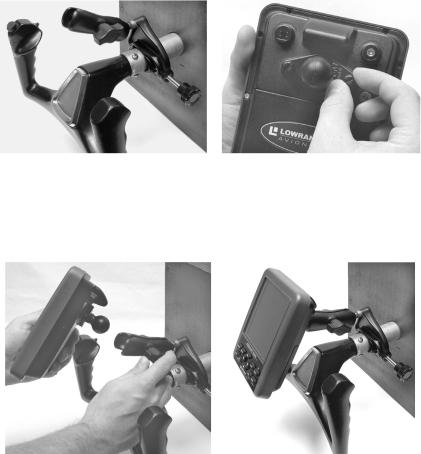
of the yoke. When you are satisfied with the bracket position, tighten the base knob to keep the bracket from shifting.
First, attach the R-A-M mounting bracket to the yoke (shown left). Then, attach the ball mount plate to the back of the AirMap case (shown right).
Now attach the ball mount plate to the back of AirMap case, as shown in the preceding image. Tighten the thumbscrews, and then fit the ball mount into the mounting bracket's arm.
Fit the ball mount into the mounting bracket's arm, and tighten the arm knob to hold the unit in place (shown left). At right, you can see an AirMap 1000 securely mounted above a yoke.
Protective Bag
Your AirMap comes with a cloth bag designed to protect the unit from minor scratches and dings when it's tucked into your flight bag or luggage. It's shown in the following image.
The bag is large enough to accommodate the unit with the ball mount plate attached. Just dismount the AirMap, drop it into the bag and pull the drawstring snug.
16
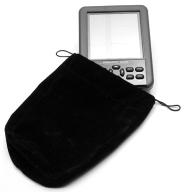
A protective cloth bag is included with your unit.
Tip:
The bag will guard against scratches on the display, but in a crowded flight bag, the Power key could be bumped and cause a battery drain. To avoid this, just pull out a battery and reinsert it upside down. This will not harm your unit, and it will prevent an inadvertent power-on. (Just remember to correctly replace the battery before take off!)
17
Notes
18
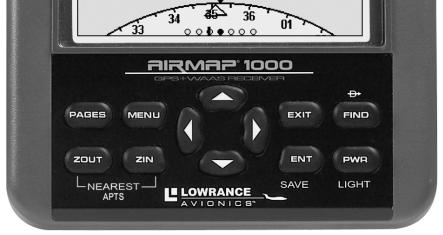
Section 3:
Aviation Operation
This section addresses AirMap's main aviation GPS functions. The principles are the same in both operating modes, so this discussion also serves as a good introduction to Land Mode work.
Before you turn on AirMap and find where you are, it's a good idea to learn about the different keys, the three Page screens and how they all work together. BUT, if you just can't wait to get outside, grab the batteries and turn to the one-page Quick Reference on page 39.
Keypad
2 |
3 |
6 |
7 |
8 |
9 |
4 |
1 |
5 |
AirMap 1000 keypad.
1.PWR/LIGHT (Power & Light) – The PWR key turns the unit on and off and activates the backlight.
2.PAGES – Pressing this key and the arrow keys will switch the unit between the three different page screens in Aviation Mode. (Satellite, Navigation and Map.) Each page represents one of the unit's major modes of operation.
3.MENU – Press this key to show the menus, which allow you to select or adjust a feature from a list.
4.ARROW KEYS – These keys are used to navigate through the menus, make menu selections, move the chart cursor and enter data.
5.ENT/SAVE (Enter & Save) – This key allows you to save data, to accept values or to execute menu commands. Also use it to quickly create waypoints or icons.
19
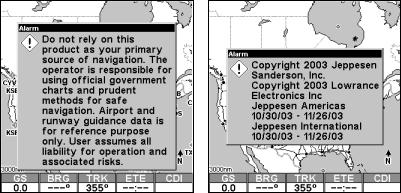
6.EXIT – The Exit key lets you return to the previous screen, clear data or erase (clear) a menu.
7.FIND  (Direct To) – The Find key launches the AirMap search menus. It also allows you to go Direct To items shown in search lists.
(Direct To) – The Find key launches the AirMap search menus. It also allows you to go Direct To items shown in search lists.
8.ZOUT – (Zoom Out) – This key lets you zoom the screen out to see a larger geographic area on the map. Less detail is seen as you zoom out.
9.ZIN – (Zoom In) – This key lets you zoom the screen in to see greater detail in a smaller geographic area on the map.
Power/lights on and off
To turn on the unit, press PWR. To turn on the backlight, press PWR again. Pressing PWR once again will turn off the backlight. (Press EXIT to clear any message or alarm displays.)
Turn off the unit by pressing and holding the PWR key for 3 seconds.
Each time your AirMap powers up, two messages appear. The first is a reminder to use your AirMap in conjunction with other navigation aids. The second is a copyright statement. Press EXIT to clear each message.
Press Exit key to clear these opening screen messages.
Main Menu
Aviation Mode has a single Main Menu, which contains some function commands and some setup option commands. The tutorials in this section will deal only with primary functions, the basic commands that make AirMap do something. These lessons are designed for use with the unit's options set at their factory defaults. But, if you want to learn more about the various option settings, see Sec. 5, System Setup and GPS Setup Options.
To access the Main Menu from any Page: press MENU|MENU. To clear the menu screen and return to the page display, press EXIT.
20
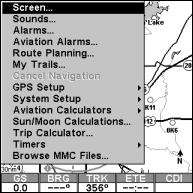
Main Menu, Aviation Mode.
The Main Menu commands and their functions are:
Screen command: changes the contrast or brightness of the display screen.
Sounds command: enables or disables the sounds for key strokes and alarms and sets the alarm style.
Alarms command: turns arrival, off course and anchor GPS alarms on or off and changes alarm thresholds.
Aviation Alarms command: turns distance, time, near and inside airspace alarms on or off and changes alarm thresholds.
Route Planning command: used to plan, view or navigate a route.
My Trails command: shows, hides, creates and deletes plot trails. Also used to navigate or backtrack a trail.
Cancel Navigation command: turns off the various navigation commands. Used to stop navigating after you have reached your destination navaid, waypoint, Point of Interest or map cursor location; or after you reach the end of a route or trail.
GPS Setup command: sets various GPS receiver options and runs the GPS Simulator.
System Setup command: sets general configuration options.
Aviation Calculators command: controls several aeronautical calculators. These include: E6B flight computer functions (altitude and air speed calculator, wind speed and direction calculator.) and a vertical
21

navigation calculator. alarm clock, up timer and down timer.
Sun/Moon Calculations command: finds the rising and setting times of the sun and moon for any location on any day from the year 2000 to 2064. This also shows the moon phase.
Trip Calculator command: shows trip status and statistics, such as trip time, distance and average speed.
Timers command: controls settings and alarms for an up timer, a down timer and an alarm clock.
Browse MMC Files command: this allows you to view the installed MMC card and the files it contains.
Pages
Aviation Mode has three main Page displays that represent the three major operating modes. They are the Satellite Status Page, the Navigation Page and the Map Page. They are accessed by pressing the PAGES key, which calls up the Pages Menu. You then press the left ← arrow key or the right → arrow key to scroll among the three pages in an endless circular loop.
The Navigation Page has two display options: Navigation Panel and Navigation With Map. The Map Page has five display options: Map Panel, Full Map, Compass Overlay, Digital Data and Two Maps. You access these display options by pressing the PAGES key, then the down ↓ arrow or up ↑ arrow keys. To clear the Pages Menu, press EXIT.
The following series of eight images shows the Pages Menu and display options on their corresponding screens.
22
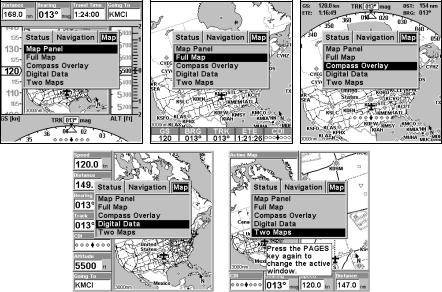
This series of figures shows the Pages Menu for all three main screens and their various display options.
Each of the three main Pages also has a submenu screen associated with it. You access a Page Submenu by pressing the MENU key one time while the page is displayed. (Pressing the MENU key twice takes you to the Main Menu.)
Several pages share similar display features. For example, the Map Page Map Panel option and the Navigation Page Navigation Panel option both have a VSI or Vertical Speed Indicator. To reduce redundancy in our text, we will describe some of these duplicate features when discussing the page on which they are most prominent.
Satellite Status Page
This Page, shown in the following images, provides detailed information on the status of AirMap's satellite lock-on and position acquisition. To get to the Satellite Status Page: press PAGES then either → or ← until the page appears, then press EXIT.
No matter what page you are on, a flashing current position indicator/question mark symbol and flashing GPS data displays indicate that satellite lock has been lost and there is no position confirmed. This page shows you the quality and accuracy of the current satellite lock-on and position calculation.
23

WARNING:
Do not begin navigating with this unit until the numbers have stopped flashing!
Satellite Page. Left view indicates unit has not locked on to any satellites and does not have a fix on its position. Center view shows satellites being scanned. Right view shows satellite-lock on with a 3D position acquired (latitude, longitude and altitude) and WAAS corrections. The bottom data box shows either a battery power indicator or a voltage indicator, depend-
ing on what power source is being used.
This screen shows a graphical view of the satellites that are in view. Each satellite is shown on the circular chart relative to your position. The point in the center of the chart is directly overhead. The small inner ring represents 45° above the horizon and the large ring represents the horizon. North is at the top of the screen. You can use this to see which satellites are obstructed by obstacles in your immediate area if you hold the unit facing north.
The GPS receiver is tracking satellites that are in bold type. The receiver hasn't locked onto a satellite if the number is grayed out, therefore it isn't being used to solve the position.
Beneath the circular graph are the bar graphs, one for each satellite in view. Since the unit has twelve channels, it can dedicate one channel per visible satellite. The taller the bar on the graph, the better the unit is receiving the signals from the satellite.
The Position Error box (sometimes called EPE for "Estimated Position Error") is shown in the upper left corner of the screen. This is the expected error from a benchmark location. In other words, if the Position Error shows 50 feet, then the position shown by the unit is estimated to be within 50 feet of the actual location. This also gives you an indicator of the fix quality the unit currently has. The smaller the position error number, the better (and more accurate) the fix is. If the position error flashes dashes, then the unit hasn't locked onto the satellites, and the number shown isn't valid.
24
